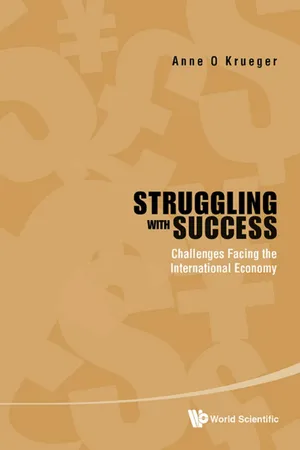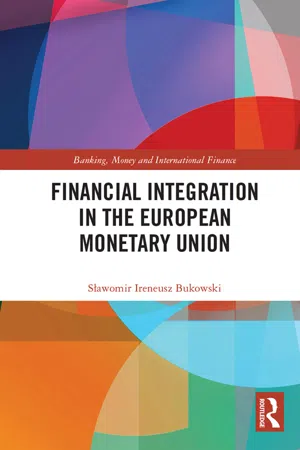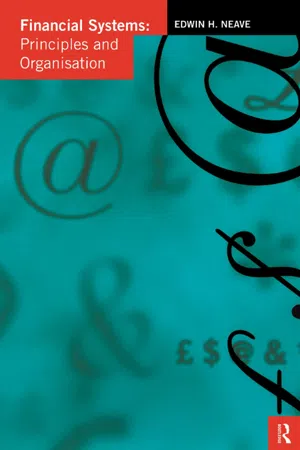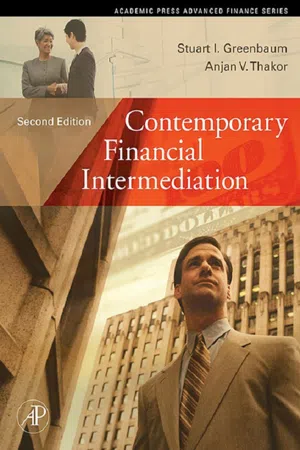Economics
Economic Functions of Financial Intermediaries
Financial intermediaries perform several key economic functions, including the transformation of maturities, risk diversification, and the reduction of information costs. By accepting funds from savers and channeling them to borrowers, they help to allocate capital efficiently in the economy. Additionally, financial intermediaries provide liquidity and facilitate the efficient functioning of financial markets.
Written by Perlego with AI-assistance
Related key terms
6 Key excerpts on "Economic Functions of Financial Intermediaries"
- James B. Ang(Author)
- 2008(Publication Date)
- Routledge(Publisher)
A well-functioning financial system leads to more efficient allocation of resources. Tobin and Brainard (1963) argue that, with the ability to evaluate investment projects, financial intermediaries allow entrepreneurs to expand their business by borrowing at lower rates and with easier terms. Financial intermediaries evaluate different investment opportunities available by assessing the associated risks so that funds are channelled to the most promising projects. This leads to improved quality of investments that can have an expansionary effect on the economy. Financial markets may have a comparative advantage over financial intermediaries to fund new innovative investment projects since market participants can acquire relevant information on firms quickly, leading to more efficient allocation of resources.Financial intermediaries and financial markets perform an important role in coordinating the saving and investment decisions of households and firms, respectively (Wicksell, 1935). Savings from households may be insufficient to fully fund a borrower. Financial systems induce mobilization of saving by pooling the savings of diverse households and making this aggregate fund available for lending. Hence, as financial systems expand, more deposits will be attracted from savers, and more funds will be available for investments. This facilitates financial intermediating activities, and hence deepens the financial systems.Efficient financial systems allow investors to diversify their portfolios and hedge against risks. With the advantage of a large number of borrowers and lenders, financial intermediaries can effectively provide liquidity by properly matching the different maturity periods of loans (Diamond and Dybvig, 1983). Emergence of financial intermediaries significantly ameliorates the liquidity risks faced by individuals, and therefore facilitates investment activities. As a result, unnecessary liquidations can be avoided (Bencivenga and Smith, 1991). Financial markets also provide ample liquidity. Many potentially lucrative investment projects require long-term commitment of capital, but investors are often reluctant to tie up their savings. Financial markets, particularly stock markets, offer a solution by allowing investors to invest in these high-return projects and yet be able to sell the investment quickly and obtain cash when necessary. This makes stock markets attractive avenues for some investors.- eBook - ePub
Other People's Money
Masters of the Universe or Servants of the People?
- John Kay(Author)
- 2015(Publication Date)
- Profile Books(Publisher)
PART IITHE FUNCTIONS OF FINANCEPart I described what the modern financial system does, how that has been affected by financialisation, and the consequences for the non-financial economy. Part II is concerned with the necessary underlying functions of a modern financial system. Economies need finance to facilitate payments, to channel the savings of individuals into fresh investment, and to enable households to manage their finances over their lifetimes and to transfer wealth between generations. These next chapters describe how, and how well, these core purposes of search for new opportunities and stewardship of existing ones are achieved. Chapter 5 reviews the central mechanism of a capitalist economy – the translation of household wealth into productive assets. Chapters 6 and 7 look at the two primary mechanisms that facilitate that process – the deposit channel and the investment channel.Passage contains an image
5Capital allocationPhysical assetsThe price or money-form of commodities is, like their form of value generally, a form quite distinct from their palpable bodily form.Karl Marx, Capital, 1867, Volume 1, Chapter 3In an ill-judged interview with the Sunday Times in 2009, Lloyd Blankfein, CEO of Goldman Sachs, claimed that his company was doing ‘God’s work’.1 The Deity’s purpose was ‘to help companies to grow by helping them to raise capital. Companies that grow create cash. This, in turn, allows people to have jobs that create more growth and more wealth. It’s a virtuous cycle.’ If you asked the occupants of the executive floors of the buildings on Wall Street or in the City of London to explain what the finance industry contributed to the real economy, their answers would echo Mr Blankfein’s (although perhaps without the divine blessing). The financial sector raises and allocates capital.A central function of financial markets is to direct money from savers to businesses, home-owners and governments. They in turn use these savings to build, own and operate houses, shops, offices, warehouses and factories, to buy plant and machinery, and to develop the nation’s infrastructure and civil works, its roads, bridges, electricity and telephone cables, pipelines and sewers. Or so it should be. - eBook - ePub
Struggling with Success
Challenges Facing the International Economy
- Anne O Krueger(Author)
- 2012(Publication Date)
- WSPC(Publisher)
Chapter 6THE CRUCIAL ROLE OF FINANCIAL INTERMEDIATION FOR RAPID GROWTH1Everyone understands that money is essential for any economy. Students of economics learn about the use of shells and stones as money in very primitive societies, and about cigarettes becoming a medium of exchange in prisoner of-war camps. It makes sense that there must be money: everyone knows it and uses it. But the crucial role of the financial system is not so obvious, in part because many financial transactions are not an everyday experience, and in part because the work that goes into a financial transaction and the benefits it brings are often invisible to most people.Economists have always taught that the financial system enables an economy to be more productive because it uses savings from those with few prospects of investing in high rate of return activities and enables those with investment opportunities but few resources to use those savings productively. In the absence of such a system, savers would obtain and hold low-return assets (such as gold and land) or simply store money (if there were a fairly stable price level) while enterprises with profitable investment opportunities would be restricted in the rate they could expand by the amount of their available cash flow.This conventional wisdom was always known and accepted by the development-growth community. But until the Asian crises of the late 1990s, most economists underestimated the positive value of a well-functioning and dynamic financial system that develops as the economy grows. Similarly they failed to comprehend the damage that was done to productivity and economic growth prospects when financial systems were repressed.To be sure, some economists knew this. My colleague at Stanford, Professor Ronald McKinnon (1973), was in the forefront of those underlining the importance of a well-functioning financial system for growth. As early as 1973, he was writing extensively on the topic, terming poorly functioning financial systems “repressed”. In his view, repressed financial systems were ones in which government regulation and controls — through state-owned banks, development banks that directed lending to priority projects and firms at below-market rates, and through directives to private banks as to the maximum interest rate they could charge and how they should allocate credit — led to low interest rates, credit rationing, and misallocation of resources. While the truth of his argument was recognized, liberalizing the financial system usually seemed to be a reform that was not “of top priority”, and could be delayed until a later date or undertaken very slowly. - Sławomir Ireneusz Bukowski(Author)
- 2019(Publication Date)
- Routledge(Publisher)
B. Scholtens and D. van Wensveen (2003, pp. 35–37) point to an essential characteristic of financial intermediation, namely creating added value for savers and investors comprised in financial instruments. This type of instrument cannot be created together or individually by savers and investors. This process of added value creation is intensified by competition between the existing financial institutions and those entering the market and introducing financial innovations. Financial institutions must continuously analyze the preferences of the financial market participants and translate these preferences into characteristics of new financial products. An important function of financial intermediation institutions is risk transformation. They create added value by creating financial instruments that absorb risk. In this way, the sector of financial intermediation institutions has evolved into the financial industry sector (see also Allen & Santomero, 1997, pp. 1461–1476; Merton & Bodie, 1995, pp. 1–27; Allen & Gale, 2001, pp. 127–149).As it was mentioned before, the relationship between the role and place in the market of financial intermediation institutions (banks, insurance societies, investment funds, etc.) and the market of financial instruments has changed. In the traditional system, direct customers of financial intermediaries – savings providers and borrowers – were households of lower income and assets and small and medium-size enterprises (SMEs).In the modern system formed as a result of the just-described phenomena related to knowledge-based economy, households and SMEs are customers of financial intermediation institutions that intermediate in investing resources obtained from them in the market of financial instruments (especially those listed in organized markets) and offering products based on exchange listed financial instruments. On the other hand, big companies benefit, to a large extent, from raising financial resources directly in organized capital markets (exchanges).It is a result of the just-described factors that financial intermediation institutions have become financial product providers creating added value. At the same time, such a state of affairs indicates the growing role of financial markets in economy and even the fact that they have become “the heart” of the financial system and market economy and the money and information “pump.”- eBook - ePub
Financial Systems
Principles and Organization
- Edwin H. Neave(Author)
- 2002(Publication Date)
- Routledge(Publisher)
This chapter examines strategic management in financial intermediaries. One of the most important of an intermediary’s strategic decisions is choosing its organisational structure. A second, equally important challenge is preparing the firm to respond to future changes—either in its markets or in the technology it might employ. The chapter first outlines the factors affecting profitability when intermediaries consider whether their organisational structure might better be that of a multiproduct or a specialised firm. Next, the chapter examines economic issues that arise in adapting to changing markets or to technological change. Third, the chapter outlines the basic economics of intermediary operations. Finally, the chapter develops a model explaining how balancing expected profitability against risk can be studied.15.2 ECONOMICS OF INTERMEDIATION
Like any financial firm, intermediaries structure themselves to meet and if possible outperform the competition. Management tries to lead or at least keep abreast of market developments, and at the same time tries to operate as profitably as possible. Meeting these two challenges means that intermediaries adapt their business to changing opportunities. As one example, intermediaries still perform their traditional role of raising funds through deposits and repackaging the funds as loans, but they are increasingly also acting as agents for financings they do not retain on their own books.In performing their traditional roles, intermediaries gather savings deposited in small individual accounts and then lend out the funds in typically larger amounts— an activity sometimes called denomination intermediation. They employ maturity intermediation when they use their short term funds (i.e., funds deposited in chequing and savings accounts) to finance medium term loans. Intermediary operations also transform risk: the depositing client of an intermediary does not face the same default risk as she would if she lent funds directly to one of the intermediary’s clients. The depositor’s risk is related to the diversified risk of the intermediary’s asset portfolio rather than to the credit risk of the borrowing client. Risk is also transformed when portfolios of intermediary loans are securitised: the original loans are repackaged into a diversified portfolio which is then offered as collateral for securities purchased by institutional investors.Despite the advantages of diversification, the uninsured depositor can still face default risk: unsound lending practices can cause an intermediary to fail. Thus when deciding where to place their short term funds, large depositors are wise to take the intermediary default risk into account. On the other hand, small depositors do not face default risk in jurisdictions where their funds are protected by deposit insurance.1 - eBook - ePub
- Stuart I. Greenbaum, Anjan V. Thakor(Authors)
- 2007(Publication Date)
- Academic Press(Publisher)
qualitative asset transformer.Our plan in the rest of this chapter is as follows. First we define financial intermediaries (F.I.s) and discuss brokerage and asset transformation services. We also provide a list of the different types of services that intermediaries provide in each of these two basic groups. Next we provide some key statistics about financial intermediaries. Then we discuss the main types of depository intermediaries: commercial banks, thrifts (savings and loan associations and mutual savings banks), credit unions, and venture capitalists. The next section discusses nondepository financial intermediaries: finance companies, insurance companies, pension funds, mutual funds, and investment banks. We cover the role of the government next and then turn to “peripheral” financial intermediaries, including pawnbrokers and loan sharks. Appendix 2.1 discusses valuation problems related to F.I. balance sheets, and Appendix 2.2 provides a summary of key regulations affecting banks.What Are Financial Intermediaries?
Definition: As the name suggests, financial intermediaries (F.I.s) are entities that intermediate between providers and users of financial capital. F.I.s are typically multifaceted, and their activities therefore can be understood from a variety of vantage points. For example, in contrast with nonfinancial firms, F.I.s hold relatively large quantities of financial claims as assets. Thus, whereas the manufacturing firm holds inventories, machines, and patents as assets, the F.I. holds contracts of the indebtedness of their clients as assets. Both finance their assets by selling their own debt and equity; there is no compelling distinction between F.I.s and others on the right-hand side of the balance sheet, except that F.I.s tend to be more leveraged. Here we have a balance sheet perspective on the uniqueness of financial intermediation. Whereas both F.I.s and other types of business finance assets with debt and equity, F.I.s tend to hold financial claims as assets whereas others are more committed to physical assets. In Appendix 2.1
Learn about this page
Index pages curate the most relevant extracts from our library of academic textbooks. They’ve been created using an in-house natural language model (NLM), each adding context and meaning to key research topics.





